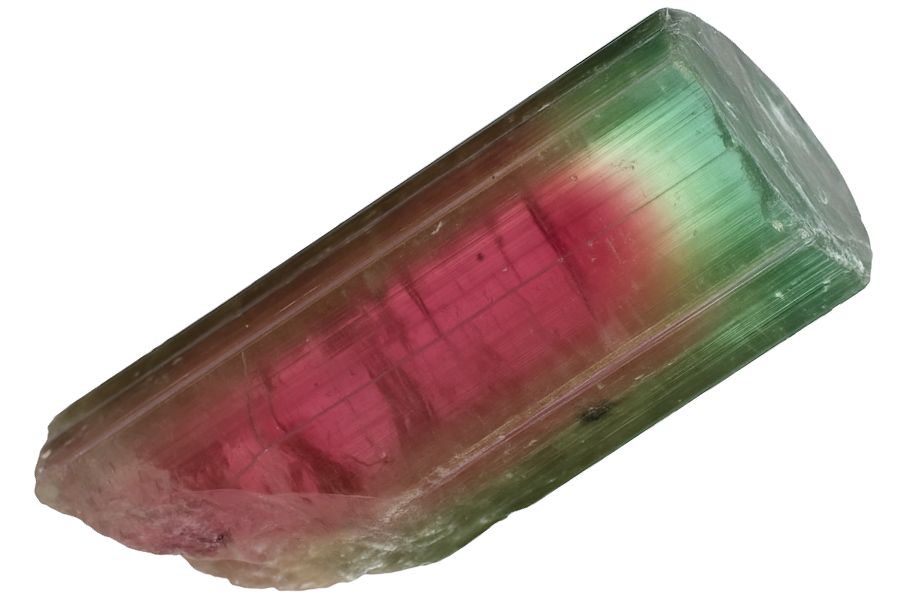Connecticut is full of opportunities for gem hunting. The state’s streams, exposed outcrops, and other natural settings often conceal colorful treasures. With a little patience, each search can turn up something unexpected.
There are many different ways to approach gem hunting in Connecticut. Searching along moving water, exploring rocky areas, or investigating older disturbed ground can all be rewarding. Simple tools and a careful eye are often enough to spot something worth keeping.
Part of the fun is never knowing exactly what you might uncover on a given trip. With this guide, you’ll learn how to pick out the right spots and recognize potential finds for you to take home.
- The extensive local experience and understanding of our team
- Input from several gem hunting groups and organizations
- The accessibility of the mining locations
- Safety and potential hazards when collecting
- Private and public locations
- A desire to include locations for both experienced gem hunters and those who are just starting out
Overall we’ve been able to put together a great list that anyone can use to locate a lot of beautiful gems.
The Gemstones Found In Connecticut You Can Mine

Although Connecticut is lucky to have access to some of the best gemstones, the conditions and accessibility of gem mining resources differ depending on where you are. After creating several tips and guides to help people find gem mines near them, we understand that very well! You can locate these rare and common gems with the proper knowledge and good fortune.
Prehnite
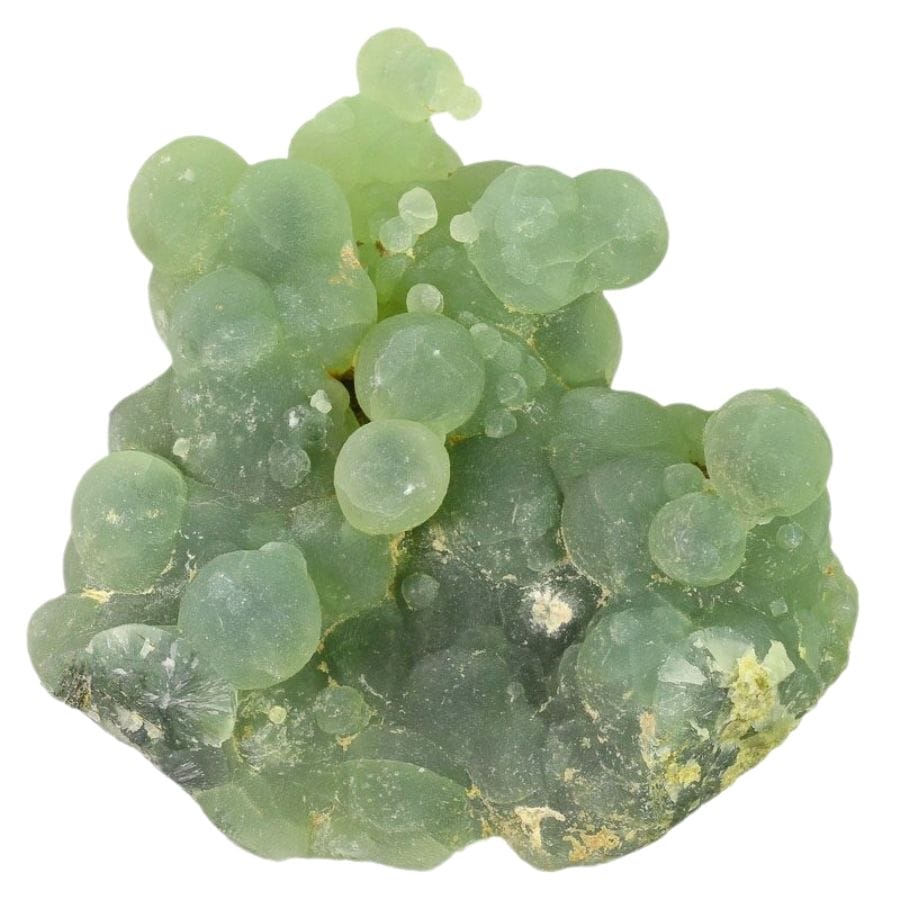
Prehnite is known for its beautiful green color, which can range from pale to a rich, deep green. It forms in the cavities of volcanic rocks as a secondary mineral, meaning it forms from the fluids that remain after the rock has solidified.
One of the remarkable things about prehnite is its crystal form. It often grows in rounded or globular aggregates, which can look like bunches of grapes.
This distinctive form, combined with its pleasing color, makes prehnite a favorite among mineral collectors.
For geologists, prehnite is valuable because finding it can provide important clues about the geological history of an area. It tells us about the conditions under which the rock it’s found in was formed.
Where you can find prehnite in Connecticut
- Woodbury, Litchfield County
- East Granby, Hartford County
- Plainville, Hartford County
Adularia

Adularia is a type of feldspar, a common group of minerals in the Earth’s crust. It has a pearly luster, which means that it has a soft, glowing sheen.
It usually appears as white or colorless crystals, but it can also show other colors like gray or yellow.
The formation of adularia is quite interesting. It often forms in cooler conditions, particularly in the cracks and cavities of rocks. This is where hot, mineral-rich water flows through and leaves behind adularia crystals as it cools.
The crystals can be small and thin, but sometimes they grow quite large, creating impressive specimens.
Finding adularia helps us understand the conditions under which certain rocks formed. It tells us about the temperatures and the fluids that were present during the rock’s formation.
For mineral collectors, adularia’s appeal lies in its delicate luster and the beauty of its crystals.
Where you can find adularia in Connecticut
- East Hampton, Middlesex County
- Derby, New Haven County
- Beacon Falls, New Haven County
Amethyst
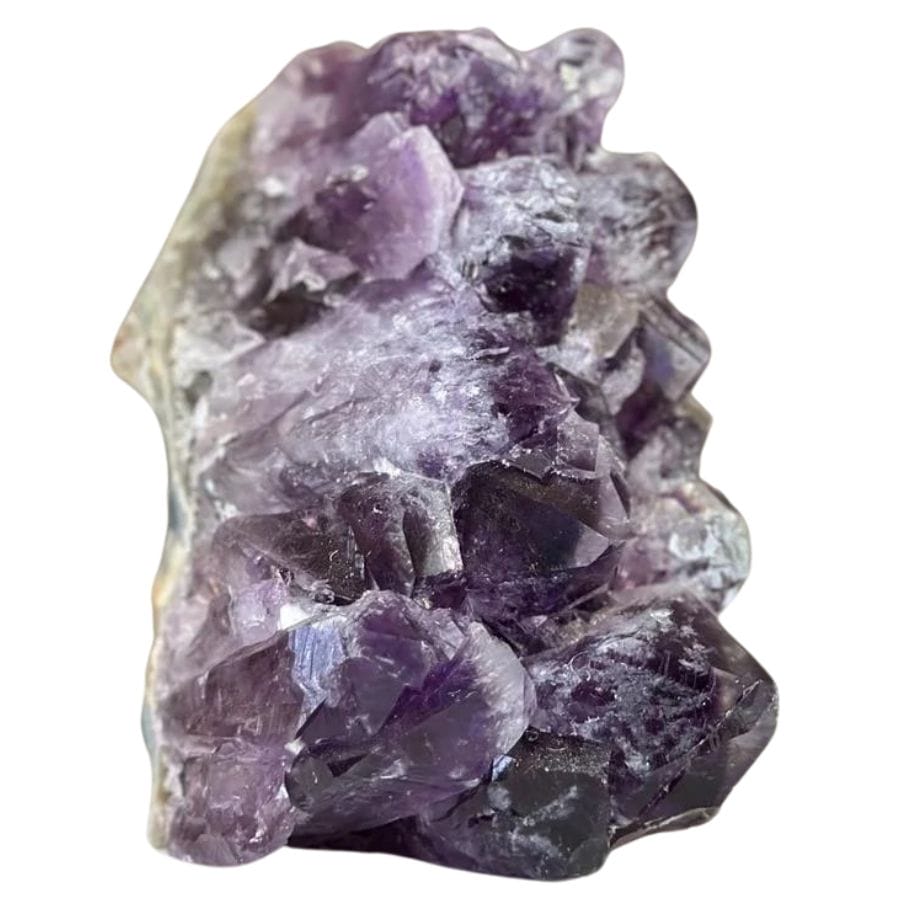
Amethyst is a stunning purple variety of quartz. It has a rich purple color, ranging from light lavender to deep violet. The color of amethyst is due to impurities of iron and other trace elements within the quartz.
When we find amethyst in Connecticut, it’s usually within rocks that have small cavities or vugs, where the crystals have had the space to grow and develop their characteristic purple color.
The captivating color of amethyst makes it a popular choice for jewelry and decorative pieces. Its durability also adds to its appeal, as it’s hard enough to be used in various types of jewelry.
It’s also of interest to collectors and geologists. Its presence in a rock can tell us about the conditions under which the rock formed, such as the temperature and the chemistry of the fluids that flowed through the rock.
Where you can find amethyst in Connecticut
- East Granby, Hartford County
- Salem, New London County
- Woodbury, Litchfield County
Aquamarine
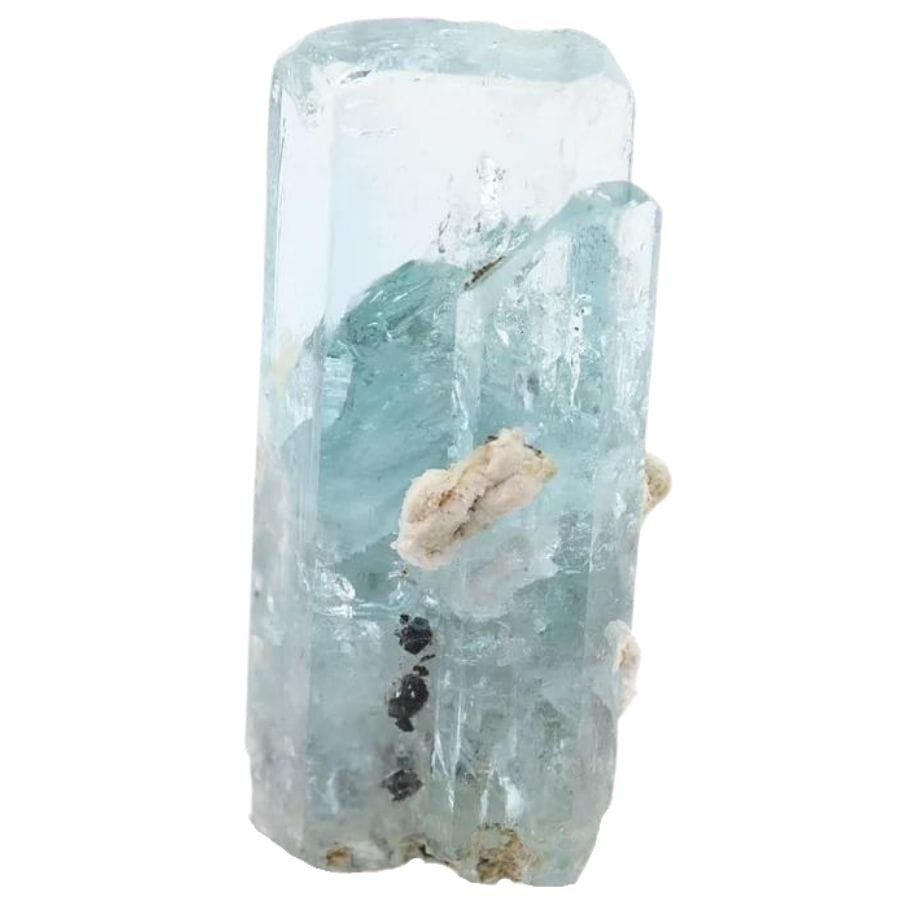
Aquamarine is a type of beryl, the same mineral family that includes emeralds, but aquamarine is known for its stunning blue to blue-green color. This color comes from trace amounts of iron in the mineral’s structure.
Aquamarine forms in granite rocks and is often found in cavities or veins within these rocks, where it grows in beautiful, hexagonal crystals.
The formation of aquamarine is a process that occurs over millions of years. As granite rocks are slowly cooled from molten magma, aquamarine crystals begin to form. The slower the cooling process, the larger the aquamarine crystals can grow.
People are often curious about how much aquamarine is worth, and it can vary widely based on different qualities.
Large, clear specimens are particularly prized. The depth of color also plays a significant role in its value; deeper and more vibrant blues are often more sought after.
Where you can find aquamarine in Connecticut
- Haddam, Middlesex County
- Portland, Middlesex County
- Glastonbury, Hartford County
Morganite
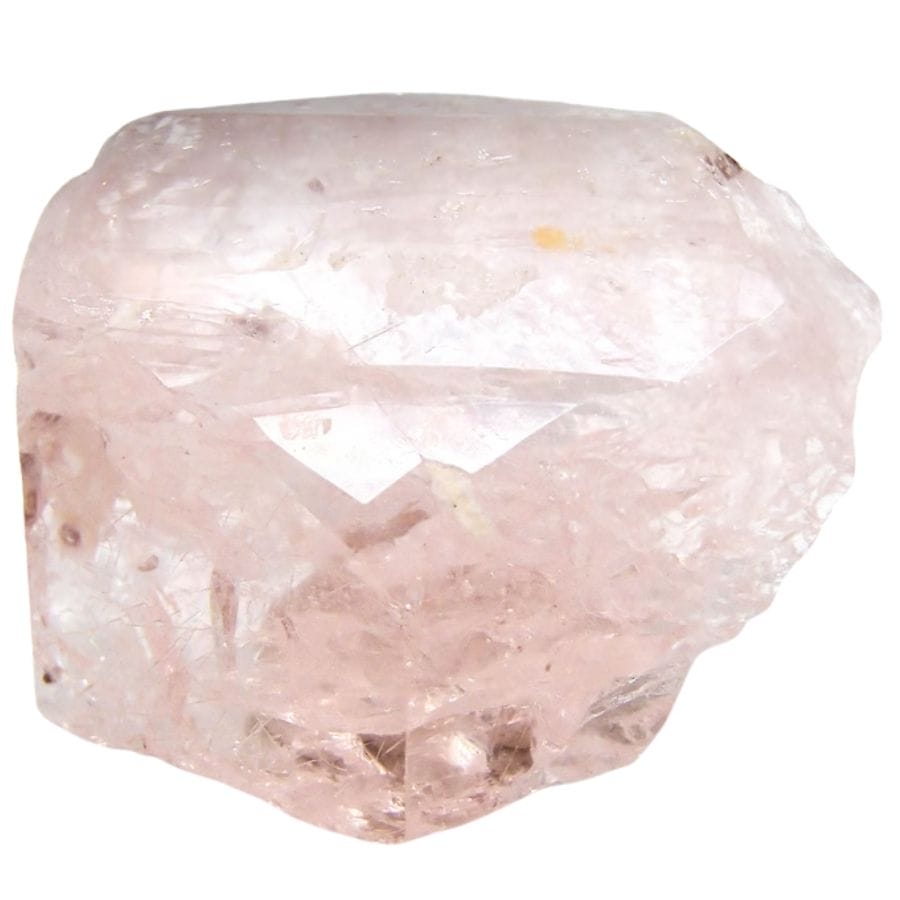
Like aquamarine, morganite is a member of the beryl family. However, morganite has a unique pink to peach color. This beautiful coloration is mainly due to traces of manganese in the crystal structure.
When we find morganite, it’s usually in the form of large crystals that can be quite impressive. The clarity and size of the crystals contribute significantly to their value.
Color is a major factor that influences how much morganite is worth. The more vivid and pink the stone, the more valuable it is. Clarity is another important aspect, as clearer stones are more sought after.
Finally, the cut of the gemstone plays a role in its value, as a well-cut stone can enhance its color and clarity.
Where you can find morganite in Connecticut
- Haddam, Middlesex County
- Middletown, Middlesex County
- Redding, Fairfield County
Opal
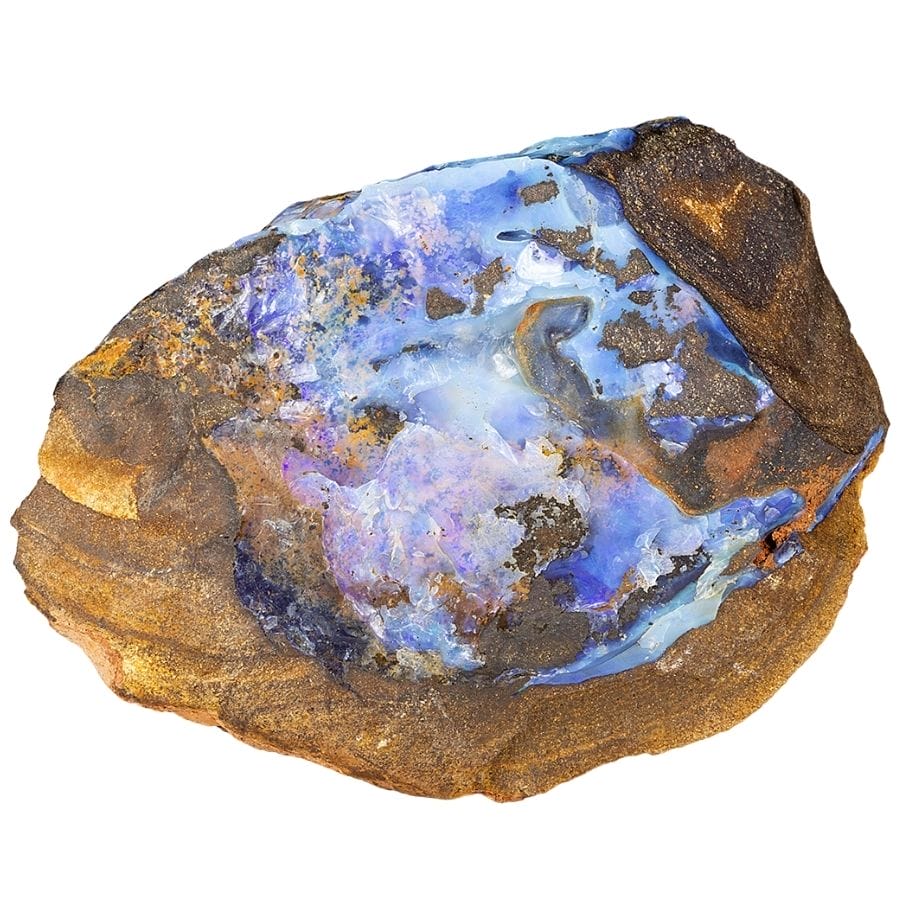
Opal is one of the most unique and captivating gemstones found in Connecticut. Unlike most other gemstones, opal does not have a crystalline structure; instead, it is amorphous, meaning its particles are arranged randomly.
This unique structure contributes to opal’s famous play-of-color, where the stone can display a variety of colors when it catches the light.
This play-of-color is the most significant factor in the value of opal; opals showing a full spectrum of colors are particularly prized. The brightness, pattern, and color range within each individual stone also play a big role.
Opals can range from milky and translucent to vibrant and fiery, with colors changing and shifting as you move the stone.
Where you can find opal in Connecticut
- Glastonbury, Hartford County
- Portland, Middlesex County
- Roxbury, Litchfield County
Topaz

Topaz comes in a wide range of colors. It can be yellow, brown, blue, green, and even colorless. This mineral forms in the cavities of granite rocks, where the last bits of mineral-rich liquids solidify as the granite cools down.
One of the interesting things about topaz is its hardness. It’s one of the hardest naturally occurring minerals, making it very durable. This hardness is a big reason why topaz is valued for jewelry, as it can withstand scratches and abrasions.
However, despite its hardness, topaz can be split with a single blow, a property known as perfect cleavage.
The clarity of topaz also contributes to its value; clear, flawless stones are highly prized.
Color is another significant factor in determining a topaz’s value. The rarer the color, like pink or red, the more valuable the stone.
Where you can find topaz in Connecticut
- Trumbull, Fairfield County
- Haddam, Middlesex County
- Middletown, Middlesex County
Tourmaline
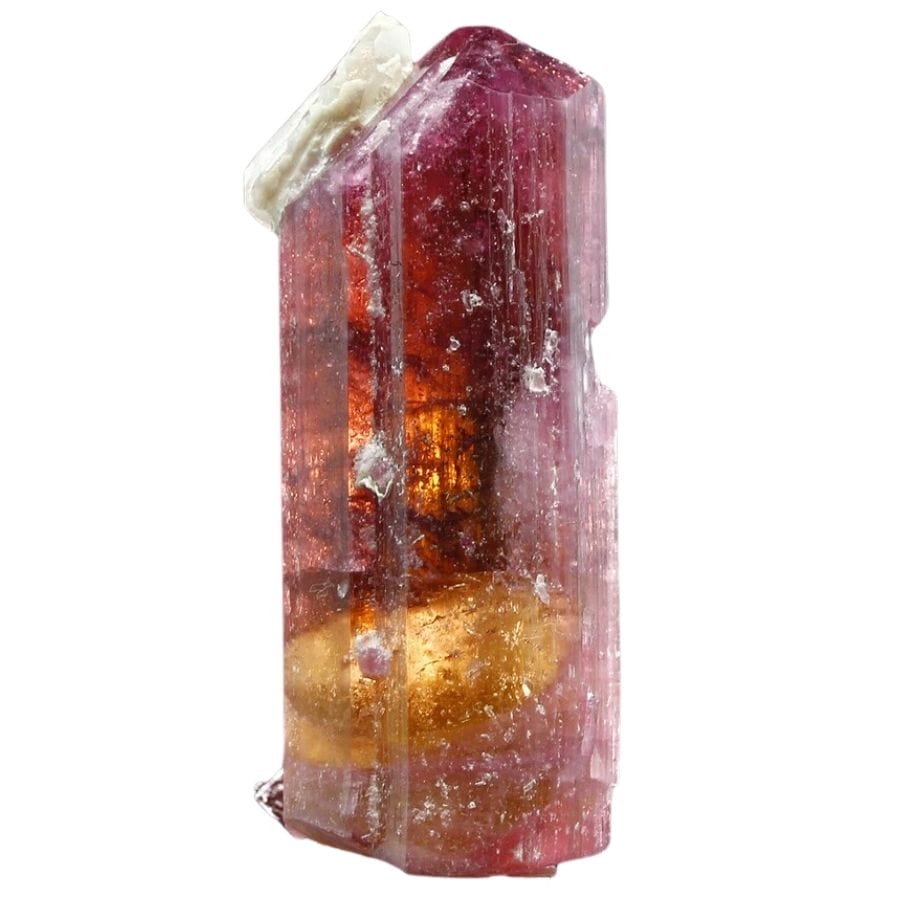
Tourmaline comes in almost every color, from deep greens and blues to vibrant pinks and reds. The variety of colors in tourmaline is due to different elements in its structure, like iron, manganese, and lithium.
One of the fascinating things about tourmaline is its ability to have multiple colors in the same crystal. This is called zoning, and it happens when the conditions change while the crystal is growing.
For example, a crystal might start growing in one color, but if the elements in the surrounding environment change, the new growth can be a different color.
The most prized tourmalines are those with vivid colors and clear transparency. Some of the rarest colors, like neon blue or pink, are especially valuable.
Where you can find tourmaline in Connecticut
- Danbury, Fairfield County
- Haddam, Middlesex County
- Portland, Middlesex County
Albite
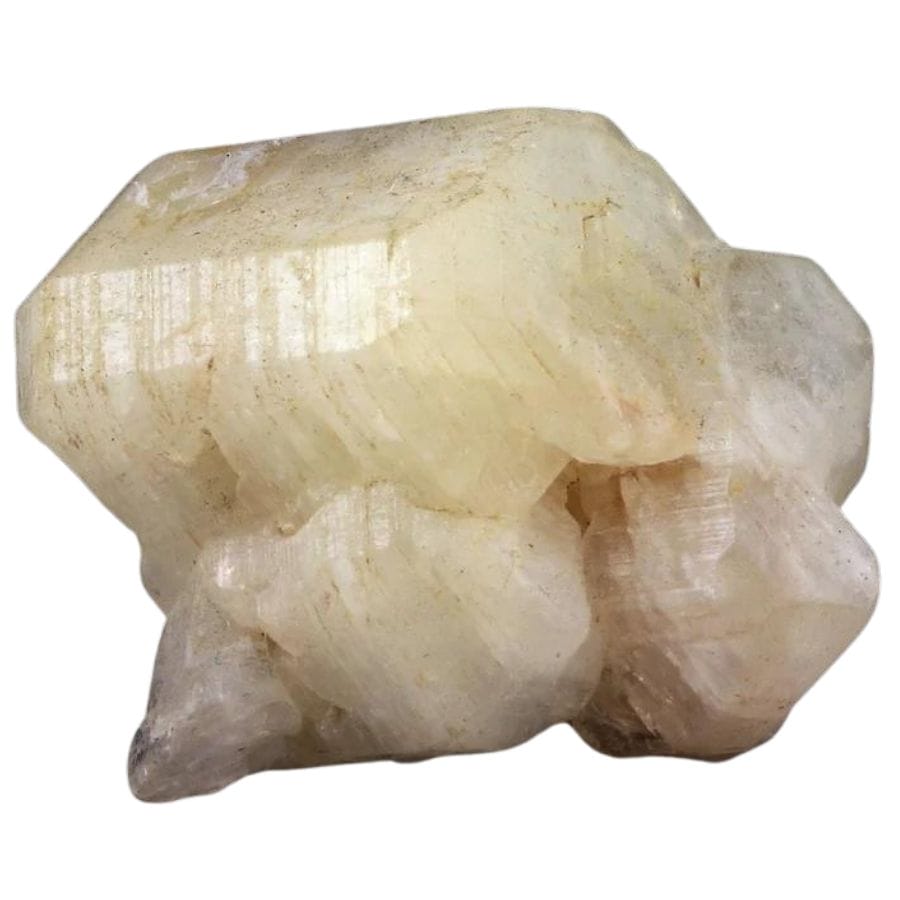
Albite is a member of the feldspar group, which is a family of minerals that make up a large part of the Earth’s crust. It’s specifically known for its white to gray color, and sometimes it can even have a bluish or greenish tint.
It has a glassy luster, which makes it look shiny like glass, and it’s usually pretty hard, making it resistant to scratches.
One of the coolest things about albite is how it forms. It usually appears in igneous rocks, but it can also show up in metamorphic rocks. Additionally, it’s often found with other rocks, like quartz.
Albite helps geologists understand the conditions under which rocks form. For example, the presence of albite can indicate the temperature and pressure conditions during the rock’s formation.
Where you can find albite in Connecticut
- Trumbull, Fairfield County
- East Hampton, Middlesex County
- Redding, Fairfield County
Calcite
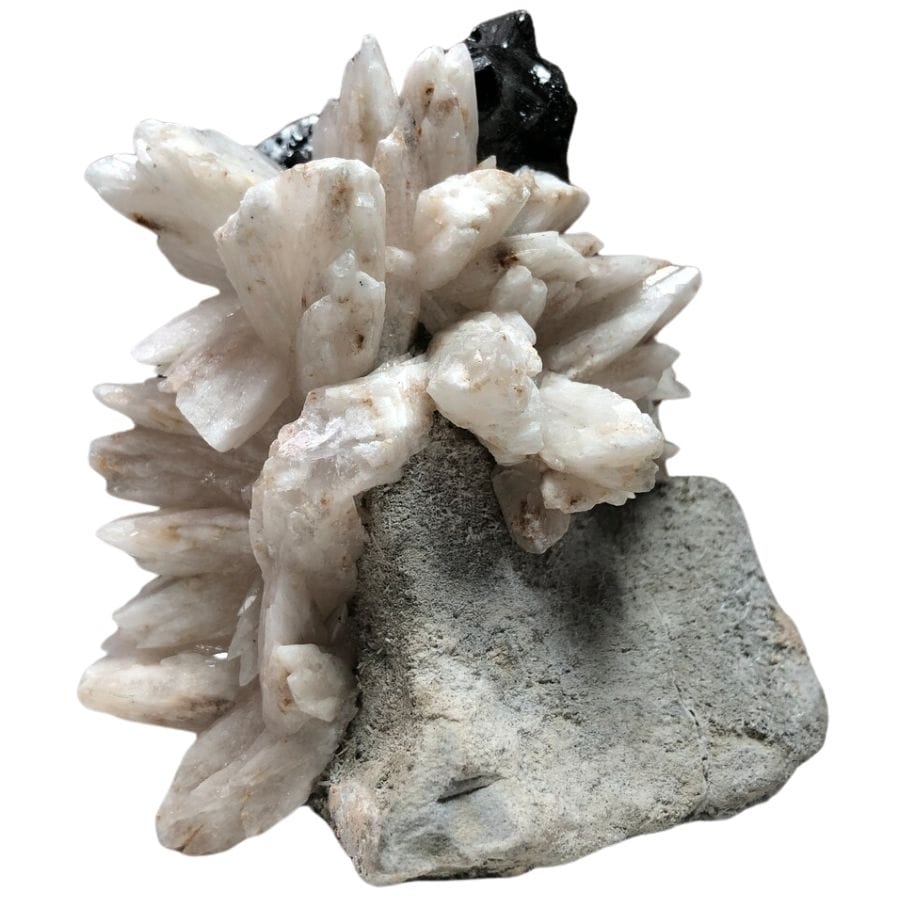
Calcite is a common mineral and can be found in a lot of places. It’s made of calcium carbonate, and it can be found in many different colors like white, yellow, and even blue or green.
One of the neatest things about calcite is that it can form in a variety of ways. It’s often found in sedimentary rocks, which form from particles settling in places like lakes or oceans.
But calcite can also grow in caves as part of stalactites and stalagmites, those icicle-like formations hanging from cave ceilings or growing from the floor.
What makes calcite especially interesting is how it reacts to acid. If you drop a small amount of weak acid, like vinegar, on calcite, it will fizz. This reaction is a big clue for geologists when they’re trying to identify minerals in the field.
Furthermore, when light passes through clear calcite crystals, it can split into two rays, creating a double image. This effect, known as double refraction, adds to the allure and value of calcite as a collector’s item.
Where you can find calcite in Connecticut
- East Granby, Hartford County
- Cheshire, New Haven County
- Brookfield, Fairfield County
Garnet
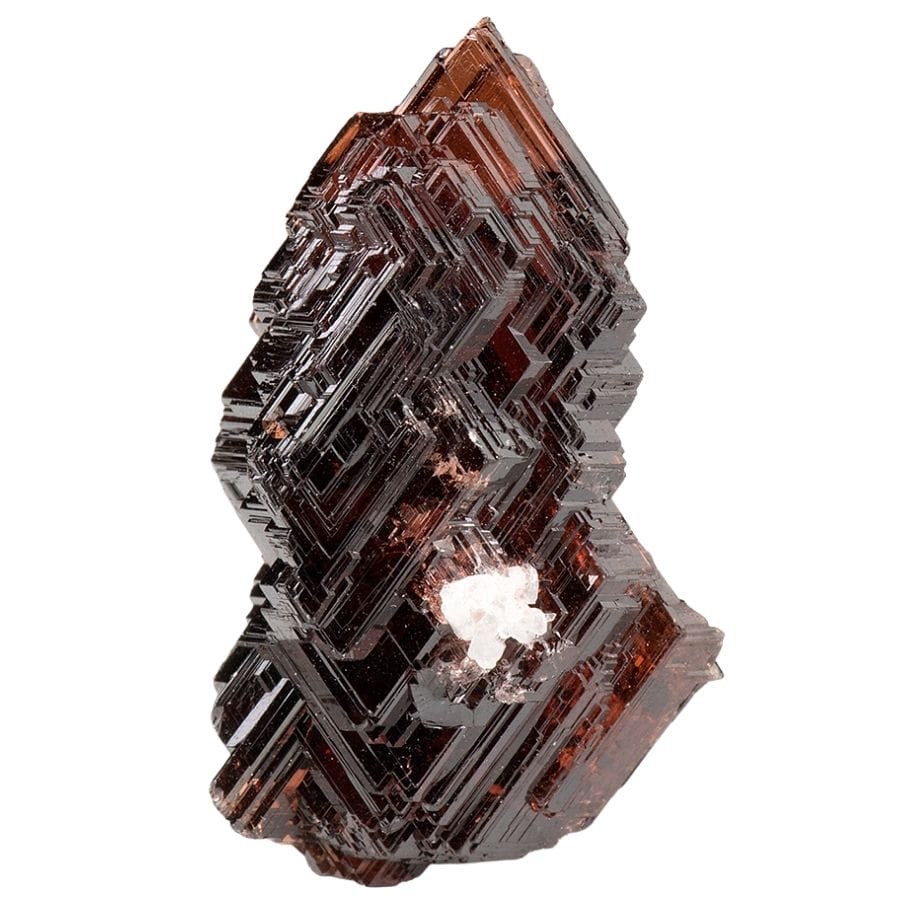
Garnet is famous for its deep red color, but garnet can also be found in a range of colors from green to yellow, and even orange and purple. In Connecticut, garnets are often found in the form of almandine, which is known for its deep, rich red color.
One of the defining features of garnet is its crystal structure. The crystals are usually shaped like little dodecahedrons, which means they have twelve flat surfaces.
The value of garnet comes from several factors. Its hardness and durability make it popular for use in jewelry, where its brilliance and color can really stand out.
Beyond its use in jewelry, garnet also has industrial uses. Because it’s so hard, it’s used in abrasive materials for things like sandpaper and waterjet cutting.
Where you can find garnet in Connecticut
- Haddam, Middlesex County
- New Milford, Litchfield County
- Bridgewater, Litchfield County
Magnetite
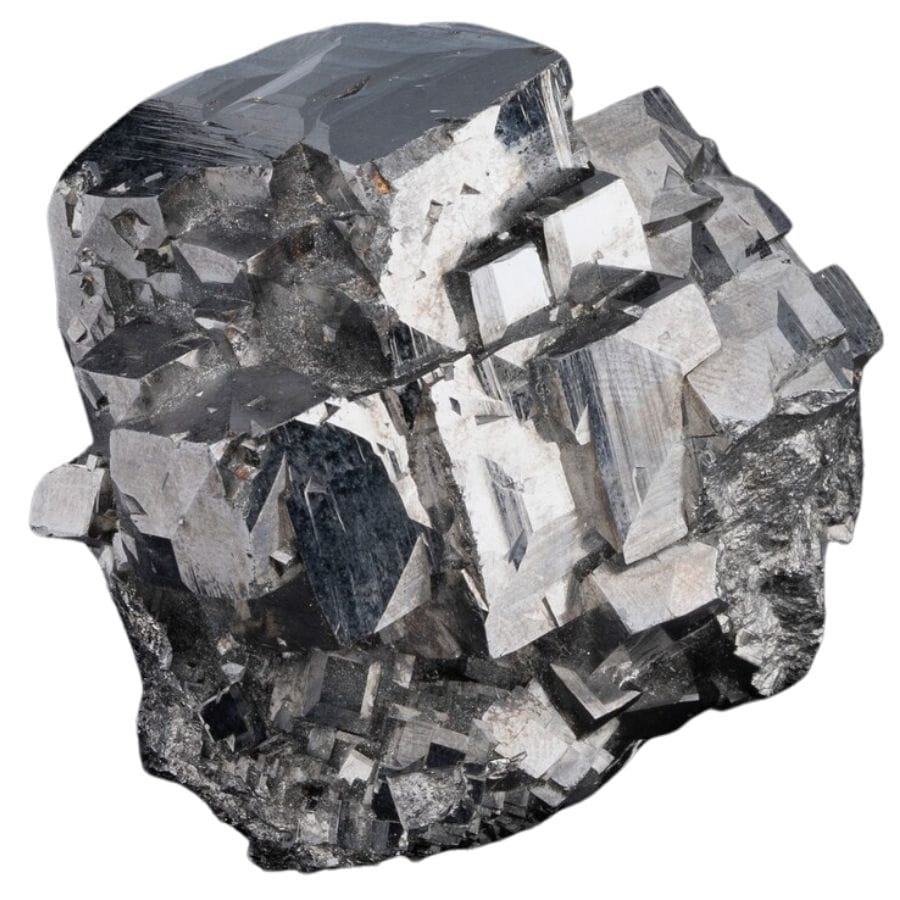
Magnetite is one of the most interesting and abundant rocks and minerals found in Connecticut. It’s a magnetic mineral, and its name comes from the fact that it has a strong magnetic pull.
This mineral is made of iron and oxygen, which gives it its characteristic color and magnetic properties.
Magnetite forms in several ways, but one common method is through volcanic activity. When lava cools down, magnetite can crystallize from the molten rock.
Another way magnetite forms is in sedimentary rocks, where it can settle out of water along with other particles.
The magnetic quality of magnetite is what makes it so valuable and interesting. It’s not just that it sticks to magnets; magnetite itself can act like a tiny magnet.
Today, magnetite’s magnetic properties are important in many scientific and industrial applications.
In addition to its magnetic qualities, magnetite is also valuable because of its iron content. It’s one of the main sources of iron ore, which is used to make steel. This makes magnetite an important mineral in the industrial world.
Where you can find magnetite in Connecticut
- Haddam, Middlesex County
- Brookfield, Fairfield County
- Pine Mountain, Litchfield County
Pyrite
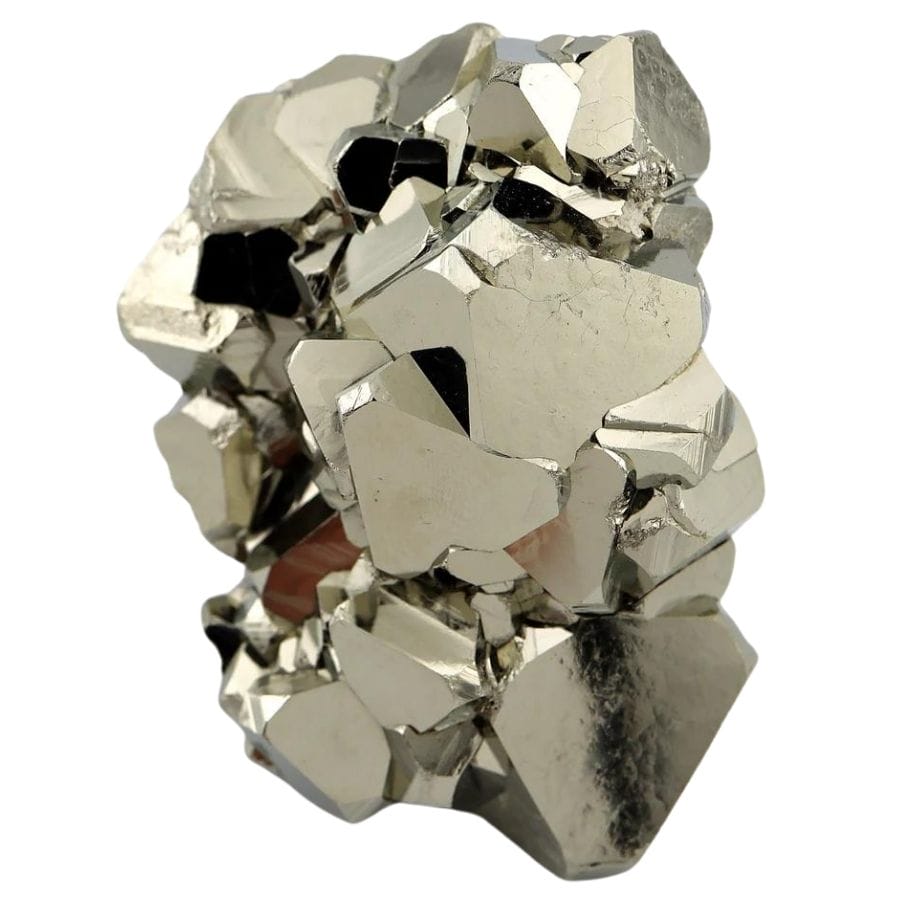
Pyrite, nicknamed “fool’s gold,” is a shiny, metallic-looking mineral that’s found in many rocks in Connecticut. It gets its nickname because it looks a lot like gold, with its yellowish-brass color and metallic luster.
It’s made up of iron and sulfur, and it forms in a variety of geological environments, often alongside other minerals like quartz and calcite.
This mineral typically forms in cubes. Because of this striking crystal shape, combined with its bright, metallic luster, pyrite is a favorite among mineral collectors.
Beyond its visual appeal, pyrite has several practical uses. It was historically used to create sparks for starting fires, as striking it against metal can cause it to spark.
In addition, pyrite is used in the production of sulfur and sulfuric acid, which are important in many manufacturing processes.
Where you can find pyrite in Connecticut
- Trumbull, Fairfield County
- Portland, Middlesex County
- Newington, Hartford County
Schorl
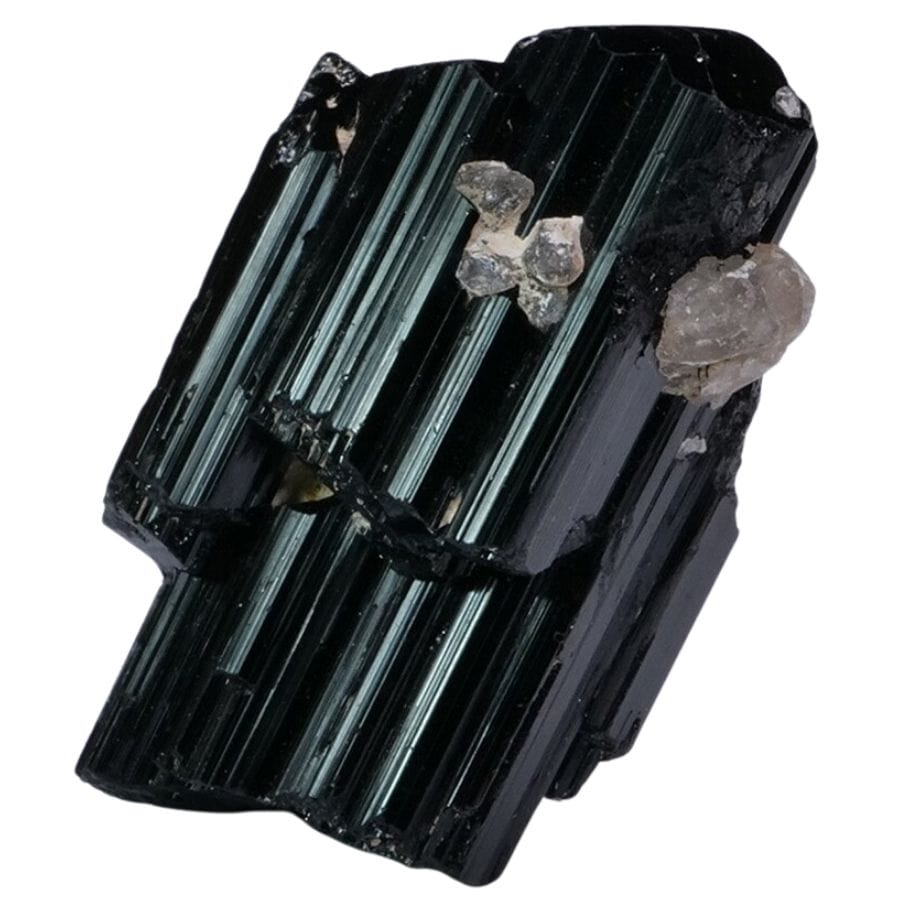
Schorl is a type of tourmaline, which is a group of minerals well-known for their interesting properties and variety of colors. In essence, schorl is the black variety of tourmaline.
It’s recognized by its deep black color and glassy luster, which makes it stand out among other types of tourmaline.
One of the most striking features of schorl is its crystal structure. It often forms long, slender crystals that can be quite striking in appearance.
These crystals can be found in a variety of rock types across Connecticut, sometimes growing with other minerals. Schorl’s hardness also makes it resistant to weathering, which is why it’s often found in good condition.
For collectors and mineral enthusiasts, schorl’s bold color and crystal forms make it a popular choice. Its durability also makes it suitable for jewelry and decorative items.
Where you can find schorl in Connecticut
- Haddam, Middlesex County
- East Hampton, Middlesex County
- Glastonbury, Hartford County
Smoky Quartz
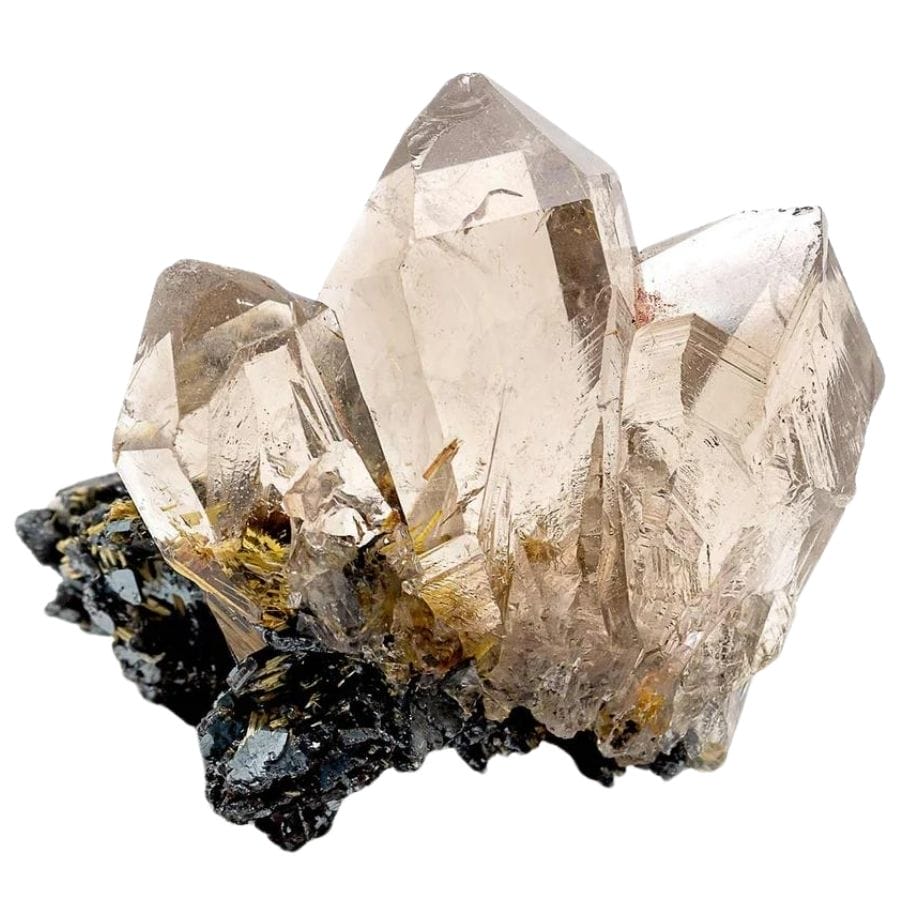
Smoky quartz stands out for its smoky color, which can range from a light brown to a deep, dark brown, almost black hue.
This unique coloration of smoky quartz is due to exposure to natural radiation from the surrounding rocks, which affects the crystal structure of the quartz.
Smoky quartz forms in the same way as clear quartz, often crystallizing from molten rock or from solutions in cracks and cavities within rocks. It’s typically found in granite and other types of rocks.
For mineral collectors, the allure of smoky quartz is in its distinctive color and crystal forms. The larger and more well-defined the crystals, the more prized the specimen is.
Smoky quartz is also popular in jewelry and ornamentation, where its unique color and durability make it a desirable choice.
Where you can find smoky quartz in Connecticut
- Willington, Tolland County
- Haddam, Middlesex County
- Glastonbury, Hartford County
Epidote
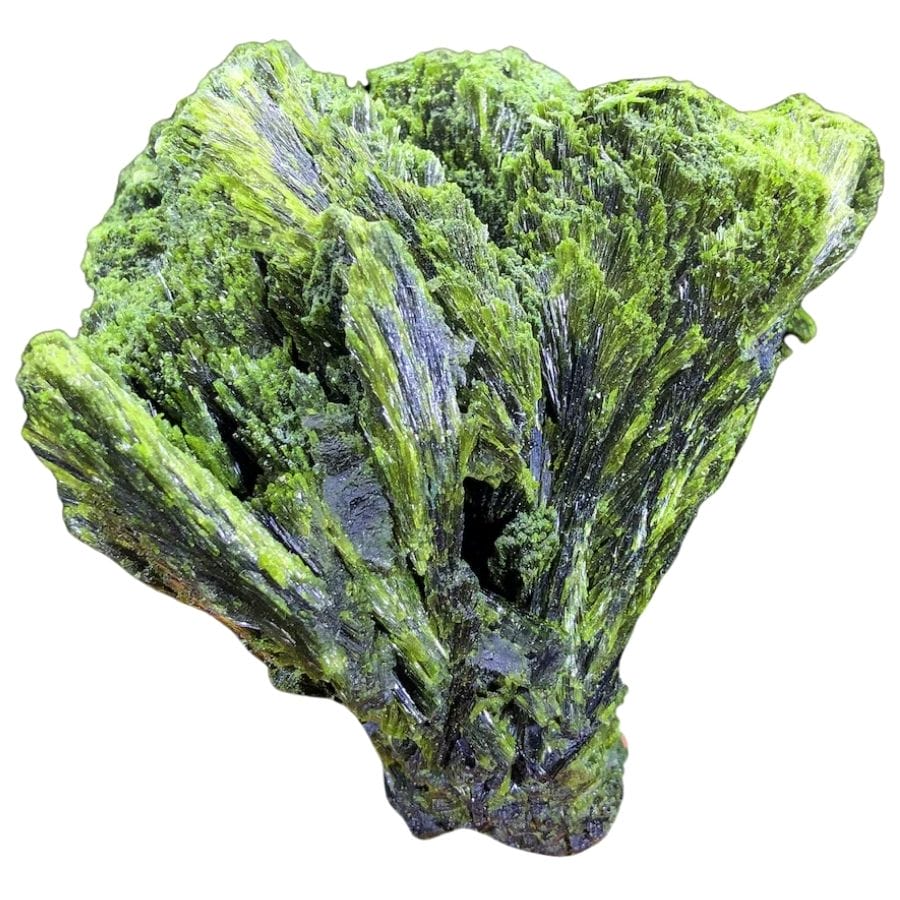
Epidote has an olive green color, which comes from its high iron content. It forms when calcium, iron, aluminum, and oxygen come together under the right conditions.
This mineral grows in long, slender crystals that can sometimes look like little columns. These crystals can be quite striking, with their deep green color and elongated shapes.
In Connecticut, we’ve found epidote in a variety of rock types, often alongside other minerals like quartz and feldspar.
One of the striking features of epidote is its crystal structure. It forms in long, slender crystals that can be quite impressive. These crystals are often clustered together, creating eye-catching mineral specimens.
Deep green, well-formed epidote crystals are especially sought after by collectors.
Where you can find epidote in Connecticut
- Coventry, Tolland County
- Portland, Middlesex County
- Haddam, Middlesex County
Dolomite
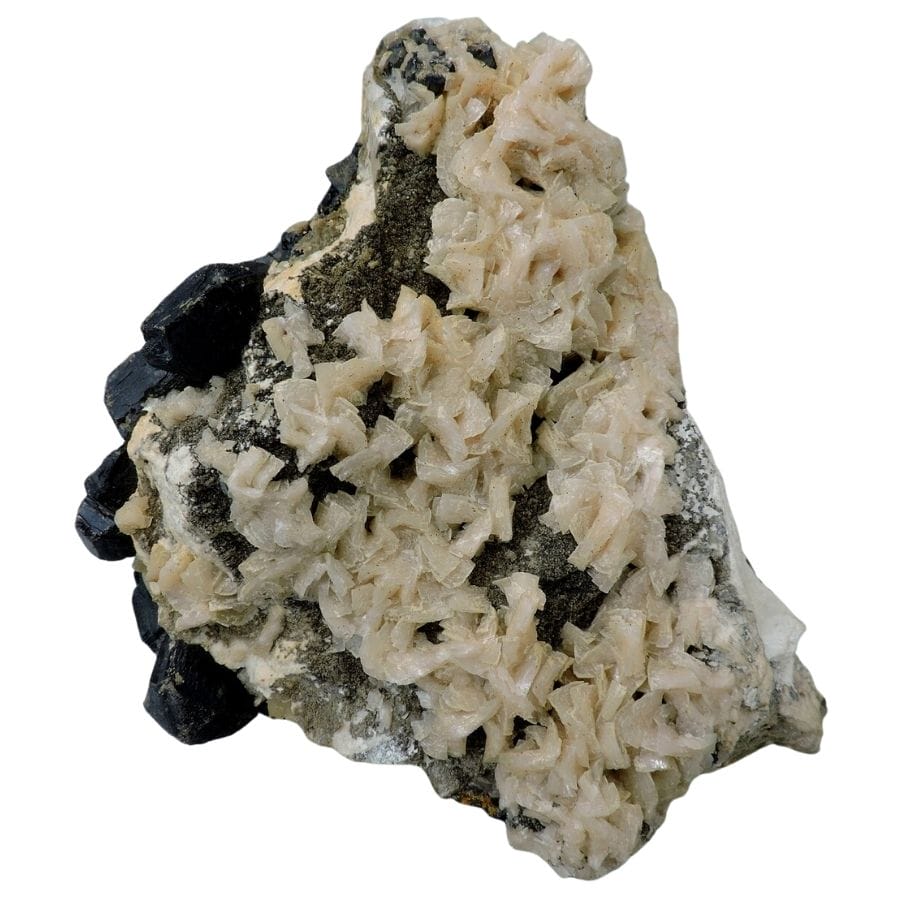
Dolomite is similar to limestone but has magnesium in it, which gives it a slightly different composition.
It forms in a couple of ways: either directly from the crystallization of magnesium-rich water or from the alteration of limestone by magnesium-rich water.
Dolomite is usually white or light gray, but it can also be pink, green, or brown, depending on impurities. It often forms small, rhombohedral crystals, which means they look like slightly tilted cubes.
This mineral can be used in various industries. It’s used in making cement and as a building material. Because dolomite can withstand high temperatures, it’s also used in furnaces and kilns.
In agriculture, dolomite is used to enrich soil with magnesium and calcium.
Where you can find dolomite in Connecticut
- New Britain, Hartford County
- North Canaan, Litchfield County
- East Haven, New Haven County
Fluorite
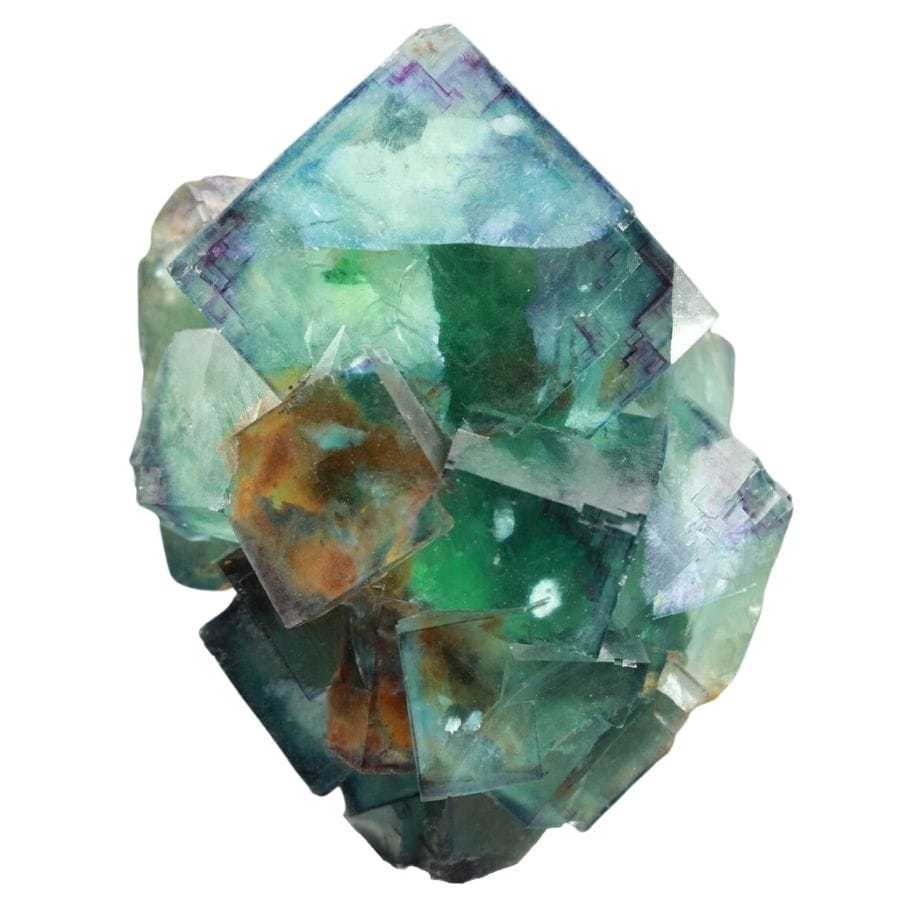
Fluorite comes in a wide variety of colors and has a beautiful, glassy appearance. It can be purple, blue, green, yellow, or even colorless, and sometimes a single crystal has multiple colors.
This variety of colors in fluorite comes from different impurities in the mineral.
Fluorite forms in a variety of geological environments, often in places where hydrothermal activity has occurred, which means it’s formed from hot, mineral-rich water.
Also, this mineral often forms cubic crystals. These well-defined shapes are fascinating to see and are a big reason why fluorite is so appealing to collectors.
Its color and clarity are also important; bright, clear crystals are more valued than dull or cloudy ones.
Additionally, its ability to fluoresce, or glow under ultraviolet light, adds to its appeal.
In addition, fluorite is also used in industry. It’s a source of fluorine, used in a variety of chemical manufacturing processes.
Where you can find fluorite in Connecticut
- Thomaston, Litchfield County
- Trumbull, Fairfield County
- Portland, Middlesex County
Goethite
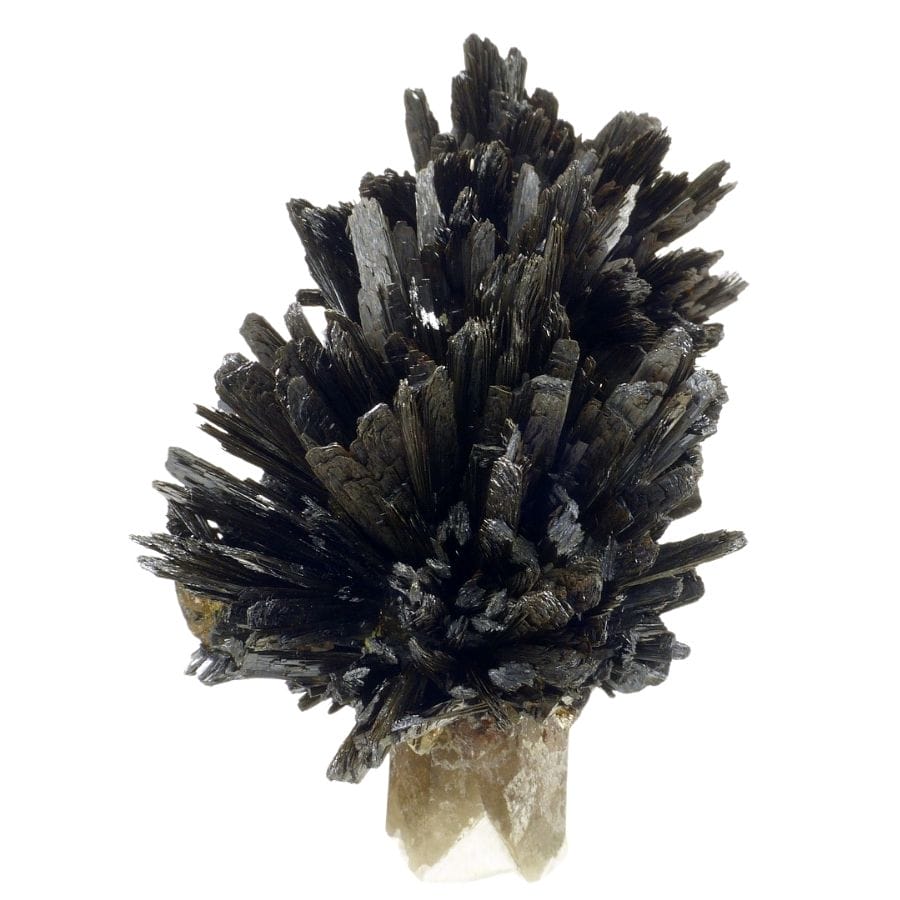
Goethite is an iron oxide mineral, known for its brown to yellow-brown color, and sometimes it even has a reddish tint. It forms in a variety of ways, often as a result of the weathering of other iron-rich minerals.
This means it can be found in places where iron minerals have been exposed to water and oxygen.
It can be found in soil, in bog iron deposits, and as a component in some types of ore. Goethite often forms in elongated or needle-like crystals, but it can also appear as earthy masses.
This mineral is an important ore of iron, which makes it valuable in a variety of industries. The way it forms can also tell us a lot about the environmental conditions of the area where it’s found.
Where you can find goethite in Connecticut
- East Haven, New Haven County
- Salisbury, Litchfield County
- East Hampton, Middlesex County
Kyanite
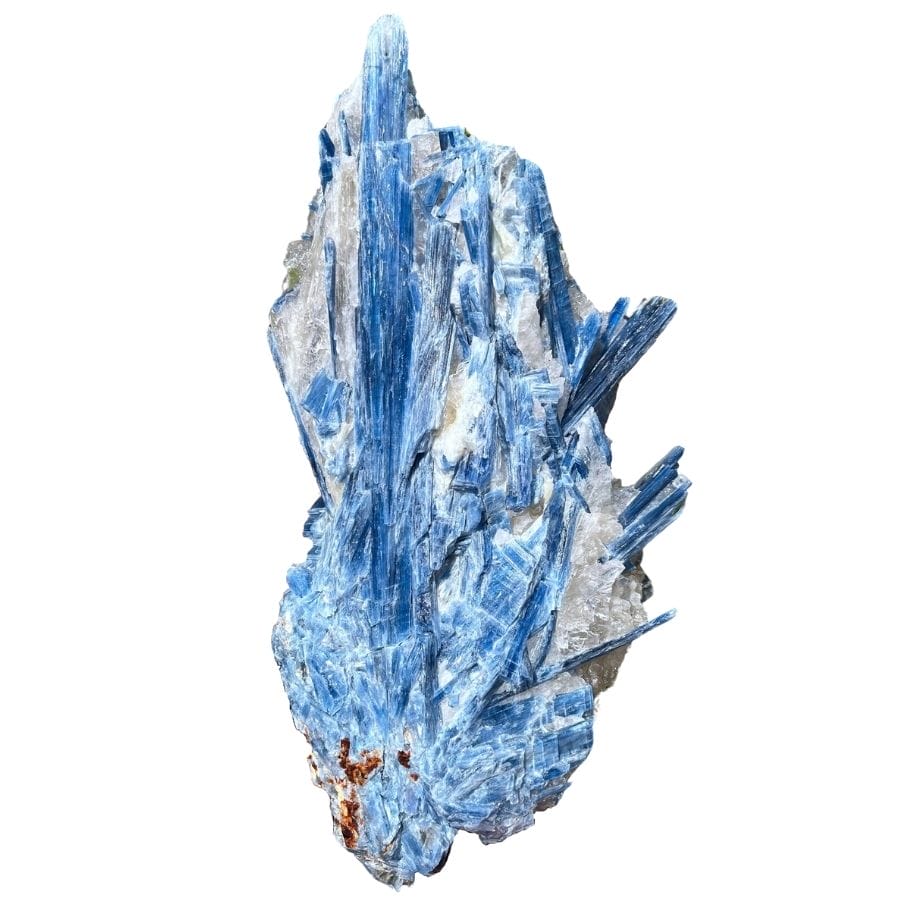
Kyanite often appears as elongated, blade-like crystals, making it easily recognizable. The distinct blue color of kyanite varies from light to dark shades, and this color is one of its most defining features.
The hardness of kyanite is quite unusual; it varies depending on the direction in which it’s tested. Along the length of the crystal, it’s quite tough. However, across the crystal, it’s much easier to break.
Kyanite’s value is influenced by several factors. Its color, clarity, and the way it’s cut can greatly affect its appeal, especially for use in jewelry. For mineral collectors, the perfect, well-formed crystals of kyanite are highly sought after.
In may industries, kyanite is valuable because it’s used to make heat-resistant products. It’s also used in making spark plugs and in the ceramics industry.
Where you can find kyanite in Connecticut
- Washington, Litchfield County
- Ratlum Mountain, Hartford County
- Redding, Fairfield County
Hematite
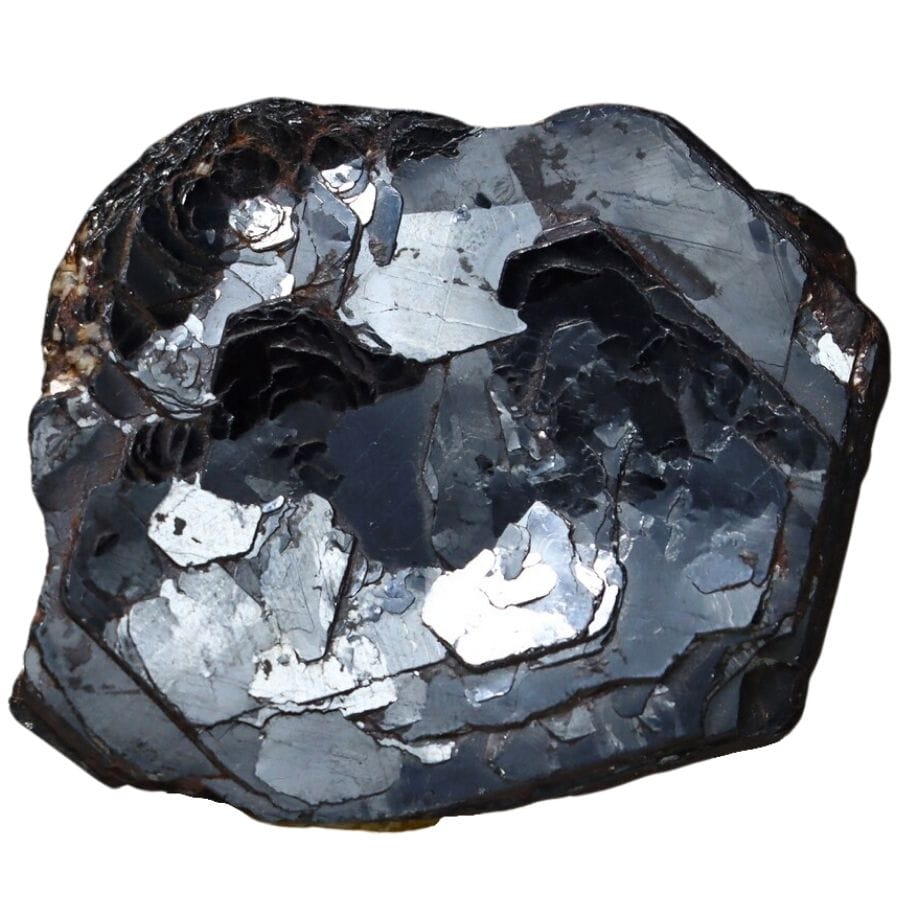
Hematite is an intriguing mineral that we often encounter in Connecticut’s rocks, known for its shiny, metallic appearance and reddish-brown color. It’s actually an iron oxide, and it gets its color from the iron content in it.
Hematite forms in several ways, but one common method is through the oxidation of iron-rich minerals. This can happen in both wet and dry environments, making hematite a pretty versatile mineral.
One of the unique things about hematite is its weight. It’s much heavier than it looks, which is a big clue for identifying it. It can form beautiful, shiny crystals, but it’s also found in more earthy, non-crystalline forms.
The metallic sheen of hematite makes it popular in jewelry and decorations. But more importantly, hematite is a major ore of iron, which means it’s used to make steel and other iron products.
This industrial use makes hematite one of the most economically important minerals.
Where you can find hematite in Connecticut
- East Granby, Hartford County
- Salisbury, Litchfield County
- East Haven, New Haven County
Zircon

Zircon is made up of zirconium, silicon, and oxygen, and it forms in both small and large, well-formed crystals. The variety of colors in zircon is due to different trace elements that get into the mineral as it forms.
One of the coolest things about zircon is that it’s the oldest known mineral on the planet. In fact, some zircon crystals have been found to be billions of years old.
In addition, zircon is one of the hardest minerals. Its hardness and resistance to weathering make it stand out in the rocks where it’s found. Zircon’s hardness and wide range of colors make it popular in jewelry.
For geologists, zircon is extremely valuable because it can be used to date the rocks in which it’s found. This is because zircon crystals can contain uranium, which allows scientists to use them to measure the age of rocks.
Where you can find zircon in Connecticut
- Middletown, Middlesex County
- Glastonbury, Hartford County
- Redding, Fairfield County
Our Favorite Places For Gem Mining in Connecticut
We’ve picked the five best areas to explore and seek gems in this state. These are just a few of the many beautiful locations available. Along with our recommendations for those experienced hunters looking where to mine for gems, we’ve also included great spots for those who wish to get started with their children.
Always Confirm Access and Collection Rules!
Before heading out to any of the locations on our list you need to confirm access requirements and collection rules for both public and private locations directly with the location. We haven’t personally verified every location and the access requirements and collection rules often change without notice.
Many of the locations we mention will not allow collecting but are still great places for those who love to find beautiful rocks and minerals in the wild without keeping them. We also can’t guarantee you will find anything in these locations since they are constantly changing.
Always get updated information directly from the source ahead of time to ensure responsible rockhounding. If you want even more current options it’s always a good idea to contact local rock and mineral clubs and groups
Walden Gem Quarry
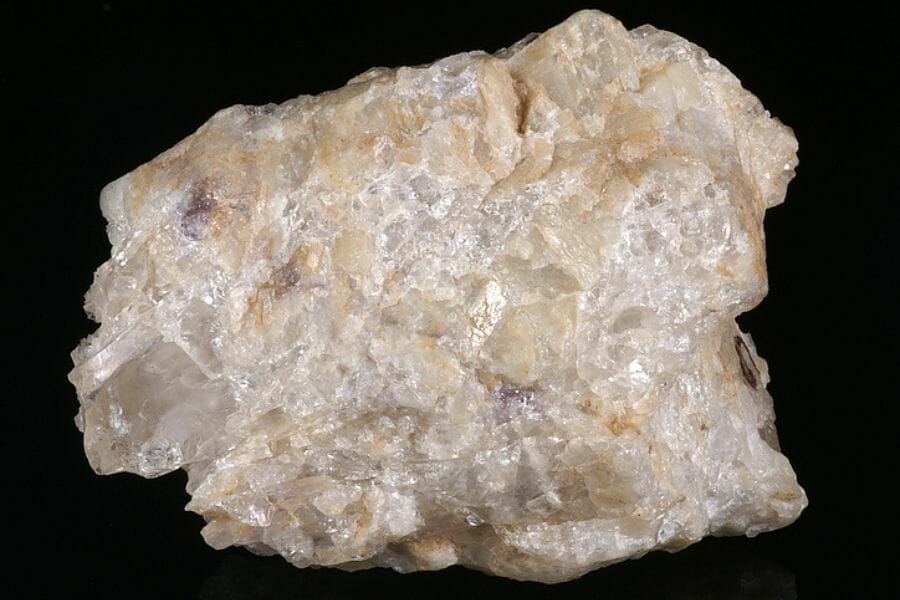
Portland, Middlesex County, Connecticut, United States
The Walden Gem Quarry is a unique geological site where amateur and professional geologists can explore and collect various gemstones found in the area. The quarry was discovered in the 1950s by a local boy and, since then, has become a popular destination for those interested in collecting gems.
The quarry also offers educational programs for adults and children, including geology lectures and hands-on activities such as rock polishing and gem identification.
The Types Of Gems Found At Walden Gem Quarry
This location is rich in precious gems. The following are some of the gems you may find here:
- Albite
- Aquamarine
- Beryl
- Garnet
- Lepidolite
- Petalite
- Pollucite
- Spodumene
It can be very hard to distinguish some of the more common gems that look so alike, so we’ve put together a few guides to help you tell specific gems apart:
The Best Time To Visit Walden Gem Quarry
The best time to visit Walden Gem Quarry is between May and September. These summer months offer longer daylight hours, allowing gem hunters more time to explore the area.
If you want REAL results finding incredible rocks and minerals you need one of these 👇👇👇
Finding the coolest rocks in isn’t luck, it's knowing what to look for. Thousands of your fellow rock hunters are already carrying Rock Chasing field guides. Maybe it's time you joined the community.
Lightweight, mud-proof, and packed with clear photos, it’s become the go-to tool for anyone interested discovering what’s hidden under our red dirt and what they've already found.
Join them, and make your next rockhounding trip actually pay off.
What makes it different:
- 📍 Find and identify 140 incredible crystals, rocks, gemstones, minerals, and geodes across the USA
- 🚙 Field-tested across America's rivers, ranchlands, mountains, and roadcuts
- 📘 Heavy duty laminated pages resist dust, sweat, and water
- 🧠 Zero fluff — just clear visuals and straight-to-the-point info
- ⭐ Rated 4.8★ by real collectors who actually use it in the field
Old Mine Park
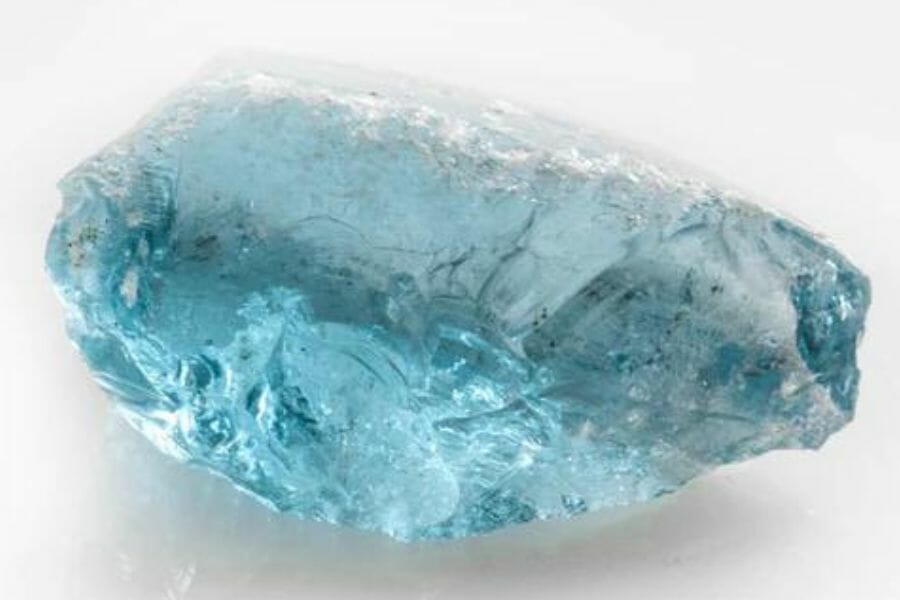
121 Old Mine Rd, Trumbull, CT 06611, United States
Old Mine Park is a historic mining site that was previously a tungsten mine. The mine was one of the first tungsten mines in the United States and produced high-grade tungsten ore for use in steel alloys and other products.
Today, the site is a popular destination for hikers, campers, gem miners, and geologists who come to see its unique geological features. You can explore the mine to seek gems, see old excavation sites, and learn about the area’s history as they wander around this fascinating site. This place is also a must-visit to find crystals in Connecticut.
The Types Of Gems Found At Old Mine Park
There are many unique gems in this area. Some of the gemstones you may discover here include the following:
- Blue Topaz
- Calcite
- Fluorite
- Pyrite
- Scheelite
The Best Time To Visit Old Mine Park
The best time to visit Old Mine Park for searching gems is during the summer months of June, July, and August, when the weather is warmer and more comfortable for outdoor activities. Gem mining is especially popular when water levels are higher and the water is more transparent.
Plum Bank Beach
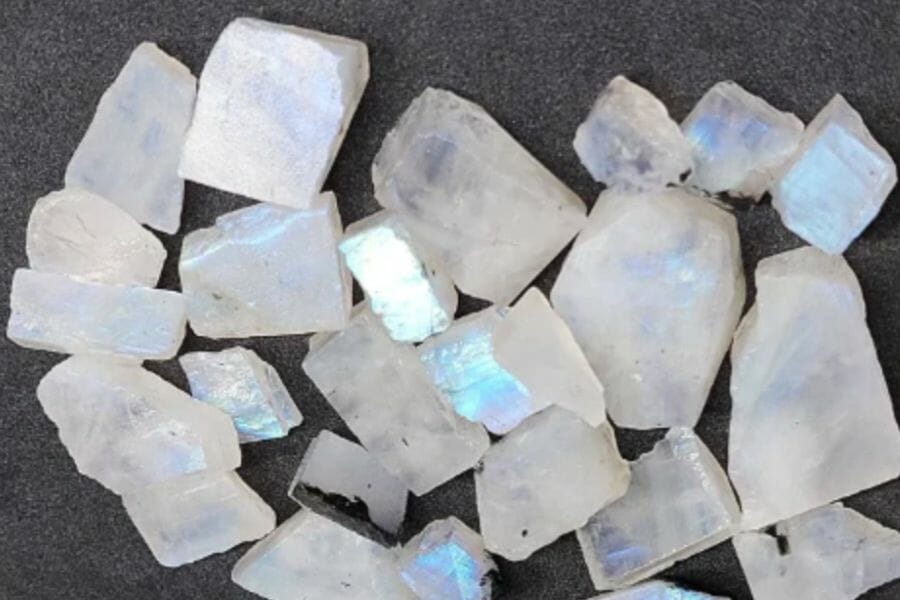
Old Saybrook, CT 06475, United States
When we visited Plum Bank Beach we found a perfect spot for an outdoor gem hunting adventure. Located on the shore of the Long Island Sound it had a surprising number of gems to collect and some truly beautiful scenery. If you prefer to collect along the beach instead of mining in the dirt you need to try this place!
The Types Of Gems Found At Plum Bank Beach
Here are a few of the gems you might locate here:
- Agates
- Moonstone
The Best Time To Visit Plum Bank Beach
The beach typically opens in late May and remains open through mid-September. The peak season for digging for gemstones at Plum Bank Beach is usually from June to August, when the water is warmest and the days are the longest.
Lucky 33 Gemstone Flume Mine – Great for kids

1353 Boston Post Rd # C, Old Saybrook, CT 06475, United States
The Lucky 33 Gemstone Flume Mine is a unique mine that is the only one of its kind in the country. The mine features a flume that carries gemstones from the depths of the earth to its surface. You can explore the flume and collect all colors, sizes, shapes, and types of gemstones.
The Lucky 33 Gemstone Flume Mine also offers educational programs for children and adults alike, as well as a variety of activities, such as panning for gems.
The Types Of Gems Found At Lucky 33 Gemstone Flume Mine
Some of the gems you could dig for here are as follows:
- Amethyst
- Calcite
- Fluorite
- Garnet
- Labradorite
- Pyrite
- Quartz
- Topaz
- Tourmaline
The Best Time To Visit Lucky 33 Gemstone Flume Mine
The flume mine is open from 9 AM – 5 PM daily, and gem hunters can pay a fee to search for gems.
Nature’s Art Village – Great for kids

1650 Hartford-New London Turnpike, Oakdale, CT 06370, United States
Nature’s Art Village is a family-friendly destination located in Oakdale. The park offers a variety of outdoor activities to enjoy, including a jackpot mine where you can dig for gemstones, a geode center, and an area to pan for gold.
Nature’s Art Village also has a museum dedicated to the history and culture of the area, as well as a nature center with interactive exhibits about the environment.
The Types Of Gems Found At Nature’s Art Village
Here are a couple of gemstones that you may discover in this location:
- Amethyst
- Aquamarine
- Citrine
- Garnet
- Peridot
- Quartz
- Topaz
- Tourmaline
The Best Time To Visit Nature’s Art Village
Nature’s Art Village accepts visitors on Saturdays and Sundays from 1 PM – 5 PM. Make sure to visit their website to purchase tickets before you explore the area.
Other Great Options For Real Gem Mining in Connecticut
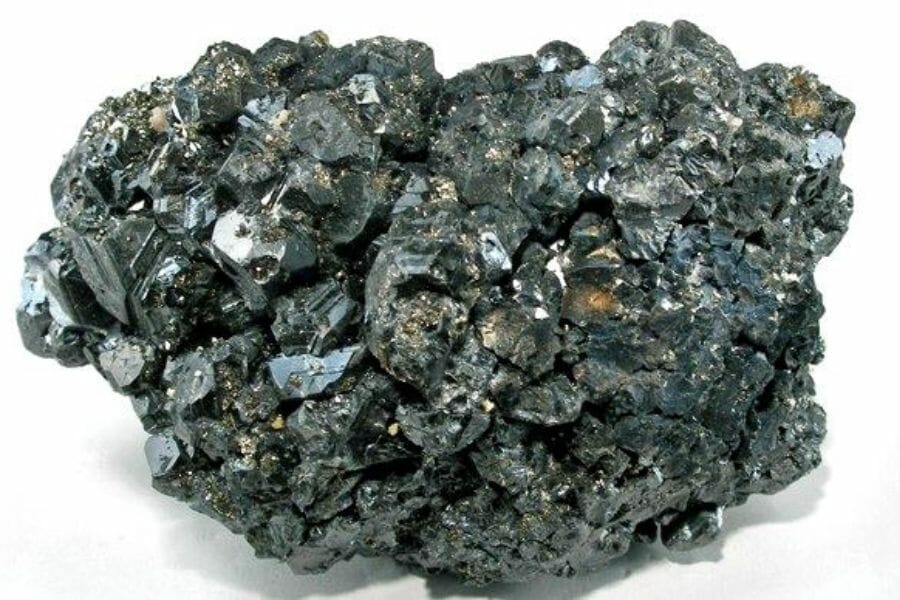
After you’ve had a chance to explore the suggested locations we listed above, Connecticut has many more fantastic sites for real gem mining. Below, we’ve highlighted locations with specific details where experienced gem miners can find more active mines.
- Bantam Lake – Quartz
- Bolton Notch State Park – Garnet, Quartz, Staurolite
- Bristol Copper Mine – Bornite, Calcite, Chrysocolla, Malachite
- Clinque Quarry – Amethyst, Smoky Quartz
- Collins Hill – Apatite, Aquamarine, Beryl Citrine, Feldspar, Quartz, Tourmaline
- East Gransby Quarry – Aragonite, Calcite, Celestine, Epidote, Fluorite, Prehnite, Quartz
- Gillette Quarry – Amazonite, Aquamarine, Beryl, Chrysoberyl, Garnet, Quartz, Tourmaline
- Hammonasset Beach State Park – Garnet
- Hubbard Park – Quartz
- Lane’s Mine – Pyrite, Sphalerite
- New Haven Traprock Quarry – Amethyst
- Old Iron Mine at Mine Hill – Chalcopyrite, Feldspar, Garnet, Quartz, Siderite, Sphalerite
- Pelton’s Quarry – Citrine, Quartz
- Pine Rock Quarry – Calcite, Prehnite, Serpentine
- Quartzite Hill – Garnet
- Riverside Quarry – Beryl, Tourmaline
- Salmon River State Forest – Garnet
The Top Public Gem Mining Locations in Connecticut
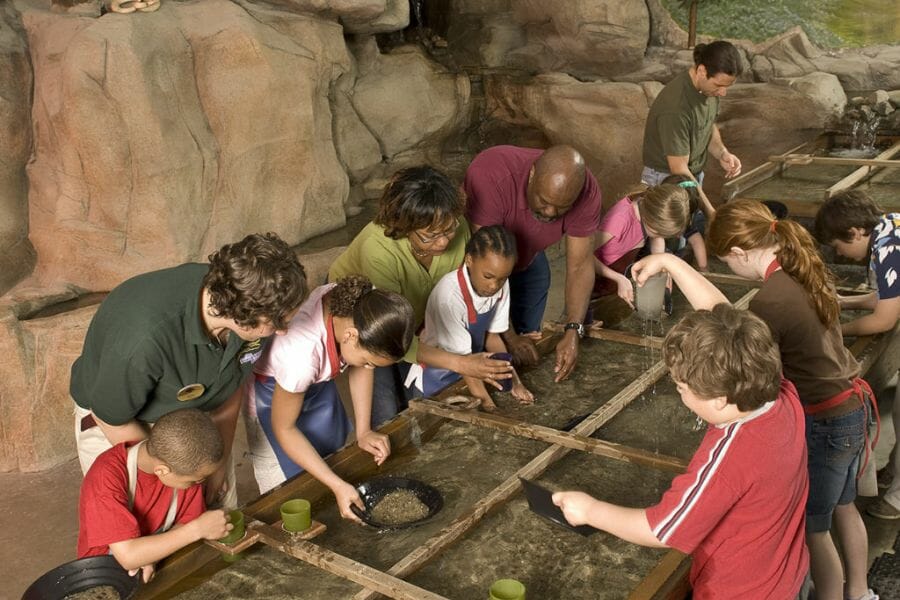
Below is our list of the state’s top family-friendly public gem mining locations. Although these are not typical mining areas, they offer fantastic activities to learn about gems and minerals.
- Lucky Strike Mine and Sluice – 41 Pond St., Oneco, CT 06373
Connecticut Gem Mining Laws And Regulations
Connecticut doesn’t have any official gem mining regulations or laws. However, any activity that disturbs the ground or vegetation may require a permit from the Department of Energy and Environmental Protection (DEEP). It’s also important to note that all recreational activities, such as gem hunting, rock collecting, and prospecting, must comply with state and federal laws. These laws protect archaeological sites, historic sites, and the environment. Collecting gems from state parks is also prohibited.
For more information about the state’s gem mining laws and regulations, visit the Department of Energy and Environment Protection (DEEP) through the link above.
Additional Places To Mine For Gems In Nearby States
If you’ve already tried all of our recommendations above or are planning a trip out of the state you should check out our guides for neighboring states:
If you have any recommendations we haven’t covered please leave them in the comments below!

